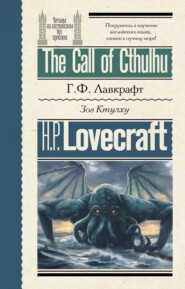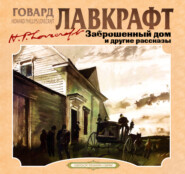По всем вопросам обращайтесь на: info@litportal.ru
(©) 2003-2025.
✖
At the Mountains of Madness
Настройки чтения
Размер шрифта
Высота строк
Поля
Our labors, however, were not very steady after 4 P.M., for about that time Lake began sending in the most extraordinary and excited messages. His working day had started unpropitiously, since an aeroplane survey of the nearly-exposed rock surfaces showed an entire absence of those Archaean and primordial strata for which he was looking, and which formed so great a part of the colossal peaks that loomed up at a tantalizing distance from the camp. Most of the rocks glimpsed were apparently Jurassic and Comanchian sandstones and Permian and Triassic schists, with now and then a glossy black outcropping suggesting a hard and slaty coal. This rather discouraged Lake, whose plans all hinged on unearthing specimens more than five hundred million years older. It was clear to him that in order to recover the Archaean slate vein in which he had found the odd markings, he would have to make a long sledge trip from these foothills to the steep slopes of the gigantic mountains themselves.
He had resolved, nevertheless, to do some local boring as part of the expedition’s general program; hence he set up the drill and put five men to work with it while the rest finished settling the camp and repairing the damaged aeroplane. The softest visible rock – a sandstone about a quarter of a mile from the camp – had been chosen for the first sampling; and the drill made excellent progress without much supplementary blasting. It was about three hours afterward, following the first really heavy blast of the operation, that the shouting of the drill crew was heard; and that young Gedney – the acting foreman – rushed into the camp with the startling news.
They had struck a cave. Early in the boring the sandstone had given place to a vein of Comanchian limestone, full of minute fossil cephalopods, corals, echini, and spirifera, and with occasional suggestions of siliceous sponges and marine vertebrate bones – the latter probably of teleosts, sharks, and ganoids. This, in itself, was important enough, as affording the first vertebrate fossils the expedition had yet secured; but when shortly afterward the drill head dropped through the stratum into apparent vacancy, a wholly new and doubly intense wave of excitement spread among the excavators. A good-sized blast had laid open the subterrene secret; and now, through a jagged aperture perhaps five feet across and three feet thick, there yawned before the avid searchers a section of shallow limestone hollowing worn more than fifty million years ago by the trickling ground waters of a bygone tropic world.
The hollowed layer was not more than seven or eight feet deep but extended off indefinitely in all directions and had a fresh, slightly moving air which suggested its membership in an extensive subterranean system. Its roof and floor were abundantly equipped with large stalactites and stalagmites, some of which met in columnar form: but important above all else was the vast deposit of shells and bones, which in places nearly choked the passage. Washed down from unknown jungles of Mesozoic tree ferns and fungi, and forests of Tertiary cycads, fan palms, and primitive angiosperms, this osseous medley contained representatives of more Cretaceous, Eocene, and other animal species than the greatest paleontologist could have counted or classified in a year. Mollusks, crustacean armor, fishes, amphibians, reptiles, birds, and early mammals – great and small, known and unknown. No wonder Gedney ran back to the camp shouting, and no wonder everyone else dropped work and rushed headlong through the biting cold to where the tall derrick marked a new-found gateway to secrets of inner earth and vanished aeons.
When Lake had satisfied the first keen edge of his curiosity, he scribbled a message in his notebook and had young Moulton run back to the camp to dispatch it by wireless. This was my first word of the discovery, and it told of the identification of early shells, bones of ganoids and placoderms, remnants of labyrinthodonts and thecodonts, great mosasaur skull fragments, dinosaur vertebrae and armor plates, pterodactyl teeth and wing bones, Archaeopteryx debris, Miocene sharks’ teeth, primitive bird skulls, and other bones of archaic mammals such as palaeotheres, Xiphodons, Eohippi, Oreodons, and titanotheres. There was nothing as recent as a mastodon, elephant, true camel, deer, or bovine animal; hence Lake concluded that the last deposits had occurred during the Oligocene Age, and that the hollowed stratum had lain in its present dried, dead, and inaccessible state for at least thirty million years.
On the other hand, the prevalence of very early life forms was singular in the highest degree. Though the limestone formation was, on the evidence of such typical imbedded fossils as ventriculites, positively and unmistakably Comanchian and not a particle earlier, the free fragments in the hollow space included a surprising proportion from organisms hitherto considered as peculiar to far older periods – even rudimentary fishes, mollusks, and corals as remote as the Silurian or Ordovician. The inevitable inference was that in this part of the world there had been a remarkable and unique degree of continuity between the life of over three hundred million years ago and that of only thirty million years ago. How far this continuity had extended beyond the Oligocene Age when the cavern was closed was of course past all speculation. In any event, the coming of the frightful ice in the Pleistocene some five hundred thousand years ago – a mere yesterday as compared with the age of this cavity – must have put an end to any of the primal forms which had locally managed to outlive their common terms.
Lake was not content to let his first message stand, but had another bulletin written and dispatched across the snow to the camp before Moulton could get back. After that Moulton stayed at the wireless in one of the planes, transmitting to me – and to the Arkham for relaying to the outside world – the frequent postscripts which Lake sent him by a succession of messengers. Those who followed the newspapers will remember the excitement created among men of science by that afternoon’s reports – reports which have finally led, after all these years, to the organization of that very Starkweather-Moore Expedition which I am so anxious to dissuade from its purposes. I had better give the messages literally as Lake sent them, and as our base operator McTighe translated them from the pencil shorthand:
“Fowler makes discovery of highest importance in sandstone and limestone fragments from blasts. Several distinct triangular striated prints like those in Archaean slate, proving that source survived from over six hundred million years ago to Comanchian times without more than moderate morphological changes and decrease in average size. Comanchian prints apparently more primitive or decadent, if anything, than older ones. Emphasize importance of discovery in press. Will mean to biology what Einstein has meant to mathematics and physics. Joins up with my previous work and amplifies conclusions.
“Appears to indicate, as I suspected, that earth has seen whole cycle or cycles of organic life before known one that begins with Archaeozoic cells. Was evolved and specialized not later than a thousand million years ago, when planet was young and recently uninhabitable for any life forms or normal protoplasmic structure. Question arises when, where, and how development took place.”
“Later. Examining certain skeletal fragments of large land and marine saurians and primitive mammals, find singular local wounds or injuries to bony structure not attributable to any known predatory or carnivorous animal of any period, of two sorts – straight, penetrant bores, and apparently hacking incisions. One or two cases of cleanly severed bones. Not many specimens affected. Am sending to camp for electric torches. Will extend search area underground by hacking away stalactites.”
“Still later. Have found peculiar soapstone fragment about six inches across and an inch and a half thick, wholly unlike any visible local formation – greenish, but no evidences to place its period. Has curious smoothness and regularity. Shaped like five-pointed star with tips broken off, and signs of other cleavage at inward angles and in center of surface. Small, smooth depression in center of unbroken surface. Arouses much curiosity as to source and weathering. Probably some freak of water action. Carroll, with magnifier, thinks he can make out additional markings of geologic significance. Groups of tiny dots in regular patterns. Dogs growing uneasy as we work, and seem to hate this soapstone. Must see if it has any peculiar odor. Will report again when Mills gets back with light and we start on underground area.”
“10:15 P.M. Important discovery. Orrendorf and Watkins, working underground at 9:45 with light, found monstrous barrel-shaped fossil of wholly unknown nature; probably vegetable unless overgrown specimen of unknown marine radiata. Tissue evidently preserved by mineral salts. Tough as leather, but astonishing flexibility retained in places. Marks of broken-off parts at ends and around sides. Six feet end to end, three and five-tenths feet central diameter, tapering to one foot at each end. Like a barrel with five bulging ridges in place of staves. Lateral breakages, as of thinnish stalks, are at equator in middle of these ridges. In furrows between ridges are curious growths – combs or wings that fold up and spread out like fans. All greatly damaged but one, which gives almost seven-foot wing spread. Arrangement reminds one of certain monsters of primal myth, especially fabled Elder Things in Necronomicon.
“Their wings seem to be membranous, stretched on frame work of glandular tubing. Apparent minute orifices in frame tubing at wing tips. Ends of body shriveled, giving no clue to interior or to what has been broken off there. Must dissect when we get back to camp. Can’t decide whether vegetable or animal. Many features obviously of almost incredible primitiveness. Have set all hands cutting stalactites and looking for further specimens. Additional scarred bones found, but these must wait. Having trouble with dogs. They can’t endure the new specimen, and would probably tear it to pieces if we didn’t keep it at a distance from them.”
“11:30 P.M. Attention, Dyer, Pabodie, Douglas. Matter of highest – I might say transcendent – importance. Arkham must relay to Kingsport Head Station at once. Strange barrel growth is the Archaean thing that left prints in rocks. Mills, Boudreau, and Fowler discover cluster of thirteen more at underground point forty feet from aperture. Mixed with curiously rounded and configured soapstone fragments smaller than one previously found – star-shaped, but no marks of breakage except at some of the points.
“Of organic specimens, eight apparently perfect, with all appendages. Have brought all to surface, leading off dogs to distance. They cannot stand the things. Give close attention to description and repeat back for accuracy Papers must get this right.
“Objects are eight feet long all over. Six-foot, five-ridged barrel torso three and five-tenths feet central diameter, one foot end diameters. Dark gray, flexible, and infinitely tough. Seven-foot membranous wings of same color, found folded, spread out of furrows between ridges. Wing framework tubular or glandular, of lighter gray, with orifices at wing tips. Spread wings have serrated edge. Around equator, one at central apex of each of the five vertical, stave-like ridges are five systems of light gray flexible arms or tentacles found tightly folded to torso but expansible to maximum length of over three feet. Like arms of primitive crinoid. Single stalks three inches diameter branch after six inches into five substalks, each of which branches after eight inches into small, tapering tentacles or tendrils, giving each stalk a total of twenty-five tentacles.
“At top of torso blunt, bulbous neck of lighter gray, with gill-like suggestions, holds yellowish five-pointed starfish-shaped apparent head covered with three-inch wiry cilia of various prismatic colors.
“Head thick and puffy, about two feet point to point, with three-inch flexible yellowish tubes projecting from each point. Slit in exact center of top probably breathing aperture. At end of each tube is spherical expansion where yellowish membrane rolls back on handling to reveal glassy, red-irised globe, evidently an eye.
“Five slightly longer reddish tubes start from inner angles of starfish-shaped head and end in saclike swellings of same color which, upon pressure, open to bell-shaped orifices two inches maximum diameter and lined with sharp, white tooth like projections – probably mouths. All these tubes, cilia, and points of starfish head, found folded tightly down; tubes and points clinging to bulbous neck and torso. Flexibility surprising despite vast toughness.
“At bottom of torso, rough but dissimilarly functioning counterparts of head arrangements exist. Bulbous light-gray pseudo-neck, without gill suggestions, holds greenish five-pointed starfish arrangement.
“Tough, muscular arms four feet long and tapering from seven inches diameter at base to about two and five-tenths at point. To each point is attached small end of a greenish five-veined membranous triangle eight inches long and six wide at farther end. This is the paddle, fin, or pseudofoot which has made prints in rocks from a thousand million to fifty or sixty million years old.
“From inner angles of starfish arrangement project two-foot reddish tubes tapering from three inches diameter at base to one at tip. Orifices at tips. All these parts infinitely tough and leathery, but extremely flexible. Four-foot arms with paddles undoubtedly used for locomotion of some sort, marine or otherwise. When moved, display suggestions of exaggerated muscularity. As found, all these projections tightly folded over pseudoneck and end of torso, corresponding to projections at other end.
“Cannot yet assign positively to animal or vegetable kingdom, but odds now favor animal. Probably represents incredibly advanced evolution of radiata without loss of certain primitive features. Echinoderm resemblances unmistakable despite local contradictory evidences.
“Wing structure puzzles in view of probable marine habitat, but may have use in water navigation. Symmetry is curiously vegetablelike, suggesting vegetable’s essential up-and-down structure rather than animal’s fore-and-aft structure. Fabulously early date of evolution, preceding even simplest Archaean protozoa hitherto known, baffles all conjecture as to origin.
“Complete specimens have such uncanny resemblance to certain creatures of primal myth that suggestion of ancient existence outside antarctic becomes inevitable. Dyer and Pabodie have read Necronomicon and seen Clark Ashton Smith’s nightmare paintings based on text, and will understand when I speak of Elder Things supposed to have created all earth life as jest or mistake. Students have always thought conception formed from morbid imaginative treatment of very ancient tropical radiata. Also like prehistoric folklore things Wilmarth has spoken of – Cthulhu cult appendages, etc.
“Vast field of study opened. Deposits probably of late Cretaceous or early Eocene period, judging from associated specimens. Massive stalagmites deposited above them. Hard work hewing out, but toughness prevented damage. State of preservation miraculous, evidently owing to limestone action. No more found so far, but will resume search later. Job now to get fourteen huge specimens to camp without dogs, which bark furiously and can’t be trusted near them.
“With nine men – three left to guard the dogs – we ought to manage the three sledges fairly well, though wind is bad. Must establish plane communication with McMurdo Sound and begin shipping material. But I’ve got to dissect one of these things before we take any rest. Wish I had a real laboratory here. Dyer better kick himself for having tried to stop my westward trip. First the world’s greatest mountains, and then this. If this last isn’t the high spot of the expedition, I don’t know what is. We’re made scientifically. Congrats, Pabodie, on the drill that opened up the cave. Now will Arkham please repeat description?”
The sensations of Pabodie and myself at receipt of this report were almost beyond description, nor were our companions much behind us in enthusiasm. McTighe, who had hastily translated a few high spots as they came from the droning receiving set, wrote out the entire message from his shorthand version as soon as Lake’s operator signed off. All appreciated the epoch-making significance of the discovery, and I sent Lake congratulations as soon as the Arkham’s operator had repeated back the descriptive parts as requested; and my example was followed by Sherman from his station at the McMurdo Sound supply cache, as well as by Captain Douglas of the Arkham. Later, as head of the expedition, I added some remarks to be relayed through the Arkham to the outside world. Of course, rest was an absurd thought amidst this excitement; and my only wish was to get to Lake’s camp as quickly as I could. It disappointed me when he sent word that a rising mountain gale made early aerial travel impossible.
But within an hour and a half interest again rose to banish disappointment. Lake, sending more messages, told of the completely successful transportation of the fourteen great specimens to the camp. It had been a hard pull, for the things were surprisingly heavy; but nine men had accomplished it very neatly. Now some of the party were hurriedly building a snow corral at a safe distance from the camp, to which the dogs could be brought for greater convenience in feeding. The specimens were laid out on the hard snow near the camp, save for one on which Lake was making crude attempts at dissection.
This dissection seemed to be a greater task than had been expected, for, despite the heat of a gasoline stove in the newly raised laboratory tent, the deceptively flexible tissues of the chosen specimen – a powerful and intact one – lost nothing of their more than leathery toughness. Lake was puzzled as to how he might make the requisite incisions without violence destructive enough to upset all the structural niceties he was looking for. He had, it is true, seven more perfect specimens; but these were too few to use up recklessly unless the cave might later yield an unlimited supply. Accordingly he removed the specimen and dragged in one which, though having remnants of the starfish arrangements at both ends, was badly crushed and partly disrupted along one of the great torso furrows.
Results, quickly reported over the wireless, were baffling and provocative indeed. Nothing like delicacy or accuracy was possible with instruments hardly able to cut the anomalous tissue, but the little that was achieved left us all awed and bewildered. Existing biology would have to be wholly revised, for this thing was no product of any cell growth science knows about. There had been scarcely any mineral replacement, and despite an age of perhaps forty million years, the internal organs were wholly intact. The leathery, undeteriorative, and almost indestructible quality was an inherent attribute of the thing’s form of organization, and pertained to some paleogean cycle of invertebrate evolution utterly beyond our powers of speculation. At first all that Lake found was dry, but as the heated tent produced its thawing effect, organic moisture of pungent and offensive odor was encountered toward the thing’s uninjured side. It was not blood, but a thick, dark-green fluid apparently answering the same purpose. By the time Lake reached this stage, all thirty-seven dogs had been brought to the still uncompleted corral near the camp, and even at that distance set up a savage barking and show of restlessness at the acrid, diffusive smell.
Far from helping to place the strange entity, this provisional dissection merely deepened its mystery. All guesses about its external members had been correct, and on the evidence of these one could hardly hesitate to call the thing animal; but internal inspection brought up so many vegetable evidences that Lake was left hopelessly at sea. It had digestion and circulation, and eliminated waste matter through the reddish tubes of its starfish-shaped base. Cursorily, one would say that its respiration apparatus handled oxygen rather than carbon dioxide, and there were odd evidences of air-storage chambers and methods of shifting respiration from the external orifice to at least two other fully developed breathing systems – gills and pores. Clearly, it was amphibian, and probably adapted to long airless hibernation periods as well. Vocal organs seemed present in connection with the main respiratory system, but they presented anomalies beyond immediate solution. Articulate speech, in the sense of syllable utterance, seemed barely conceivable, but musical piping notes covering a wide range were highly probable. The muscular system was almost prematurely developed.
The nervous system was so complex and highly developed as to leave Lake aghast. Though excessively primitive and archaic in some respects, the thing had a set of ganglial centers and connectives arguing the very extremes of specialized development. Its five-lobed brain was surprisingly advanced, and there were signs of a sensory equipment, served in part through the wiry cilia of the head, involving factors alien to any other terrestrial organism. Probably it has more than five senses, so that its habits could not be predicted from any existing analogy. It must, Lake thought, have been a creature of keen sensitiveness and delicately differentiated functions in its primal world – much like the ants and bees of today. It reproduced like the vegetable cryptogams, especially the Pteridophytes, having spore cases at the tips of the wings and evidently developing from a thallus or prothallus.
But to give it a name at this stage was mere folly. It looked like a radiate, but was clearly something more. It was partly vegetable, but had three-fourths of the essentials of animal structure. That it was marine in origin, its symmetrical contour and certain other attributes clearly indicated; yet one could not be exact as to the limit of its later adaptations. The wings, after all, held a persistent suggestion of the aerial. How it could have undergone its tremendously complex evolution on a new-born earth in time to leave prints in Archaean rocks was so far beyond conception as to make Lake whimsically recall the primal myths about Great Old Ones who filtered down from the stars and concocted earth life as a joke or mistake; and the wild tales of cosmic hill things from outside told by a folklorist colleague in Miskatonic’s English department.
Naturally, he considered the possibility of the pre-Cambrian prints having been made by a less evolved ancestor of the present specimens, but quickly rejected this too-facile theory upon considering the advanced structural qualities of the older fossils. If anything, the later contours showed decadence rather than higher evolution. The size of the pseudo-feet had decreased, and the whole morphology seemed coarsened and simplified. Moreover, the nerves and organs just examined held singular suggestions of retrogression from forms still more complex. Atrophied and vestigial parts were surprisingly prevalent. Altogether, little could be said to have been solved; and Lake fell back on mythology for a provisional name – jocosely dubbing his finds “The Elder Ones.”
At about 2:30 A.M., having decided to postpone further work and get a little rest, he covered the dissected organism with a tarpaulin, emerged from the laboratory tent, and studied the intact specimens with renewed interest. The ceaseless antarctic sun had begun to limber up their tissues a trifle, so that the head points and tubes of two or three showed signs of unfolding; but Lake did not believe there was any danger of immediate decomposition in the almost subzero air. He did, however, move all the undissected specimens close together and throw a spare tent over them in order to keep off the direct solar rays. That would also help to keep their possible scent away from the dogs, whose hostile unrest was really becoming a problem, even at their substantial distance and behind the higher and higher snow walls which an increased quota of the men were hastening to raise around their quarters. He had to weight down the corners of the tent cloth with heavy blocks of snow to hold it in place amidst the rising gale, for the titan mountains seemed about to deliver some gravely severe blasts. Early apprehensions about sudden antarctic winds were revived, and under Atwood’s supervision precautions were taken to bank the tents, new dog corral, and crude aeroplane shelters with snow on the mountainward side. These latter shelters, begun with hard snow blocks during odd moments, were by no means as high as they should have been; and Lake finally detached all hands from other tasks to work on them.
It was after four when Lake at last prepared to sign off and advised us all to share the rest period his outfit would take when the shelter walls were a little higher. He held some friendly chat with Pabodie over the ether, and repeated his praise of the really marvelous drills that had helped him make his discovery. Atwood also sent greetings and praises. I gave Lake a warm word of congratulations, owning up that he was right about the western trip, and we all agreed to get in touch by wireless at ten in the morning. If the gale was then over, Lake would send a plane for the party at my base. Just before retiring I dispatched a final message to the Arkham with instructions about toning down the day’s news for the outside world, since the full details seemed radical enough to rouse a wave of incredulity until further substantiated.
III
None of us, I imagine, slept very heavily or continuously that morning. Both the excitement of Lake’s discovery and the mounting fury of the wind were against such a thing. So savage was the blast, even where we were, that we could not help wondering how much worse it was at Lake’s camp, directly under the vast unknown peaks that bred and delivered it. McTighe was awake at ten o’clock and tried to get Lake on the wireless, as agreed, but some electrical condition in the disturbed air to the westward seemed to prevent communication. We did, however, get the Arkham, and Douglas told me that he had likewise been vainly trying to reach Lake. He had not known about the wind, for very little was blowing at McMurdo Sound, despite its persistent rage where we were.
Throughout the day we all listened anxiously and tried to get Lake at intervals, but invariably without results. About noon a positive frenzy of wind stampeded out of the west, causing us to fear for the safety of our camp; but it eventually died down, with only a moderate relapse at 2 P.M. After three o’clock it was very quiet, and we redoubled our efforts to get Lake. Reflecting that he had four planes, each provided with an excellent short-wave outfit, we could not imagine any ordinary accident capable of crippling all his wireless equipment at once. Nevertheless the stony silence continued, and when we thought of the delirious force the wind must have had in his locality we could not help making the more direful conjectures.

















